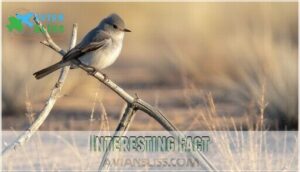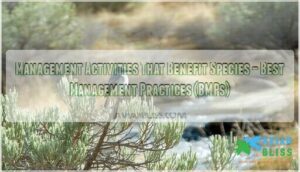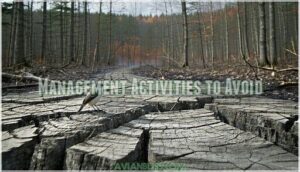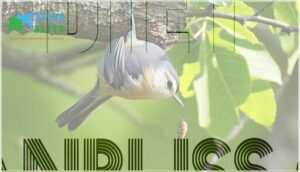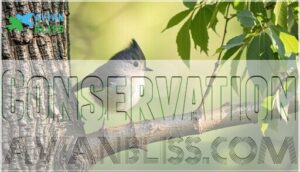This site is supported by our readers. We may earn a commission, at no cost to you, if you purchase through links.

Look for its gentle tail dip, a signature move that sets it apart from its cousins. The gray flycatcher snags insects midair, using patient, calculated flights from low perches.
It’s a small bird, but its role in controlling insect populations is mighty. Nesting low in shrubs, it prefers quiet, undisturbed places.
Habitat loss and invasive plants can threaten its numbers, but smart land management helps. Curious about its migration secrets or how to spot its nest? There’s more ahead.
Table Of Contents
- Key Takeaways
- Identification
- Habitat
- Diet
- Physical Characteristics
- Behavior
- Nesting
- Conservation
- Frequently Asked Questions (FAQs)
- How do you identify a Gray Flycatcher?
- What is the gray flycatchers habitat?
- What is the difference between a dusky flycatcher and a Gray Flycatcher?
- What does it mean when you see a flycatcher?
- How do you identify a GREY flycatcher?
- What is the difference between a GREY flycatcher and a dusky flycatcher?
- What does a gray flycatcher eat?
- What does a gray flycatcher look like?
- What is a Merlin Gray flycatcher?
- Where do gray flycatchers live?
- Conclusion
Key Takeaways
- You can spot a gray flycatcher by its slim shape, pale grayish-olive feathers, white eye ring, and its unique habit of dipping its tail downward.
- You’ll find these birds in arid sagebrush plains and open woodlands, where they nest low in shrubs and hunt insects from exposed perches.
- Don’t confuse them with similar species—watch for the downward tail dip and listen for sharp “chebek” calls to confirm your ID.
- You help gray flycatchers thrive by supporting smart land management, like preserving sagebrush habitats and reducing pesticide use.
Identification
Identifying a Gray Flycatcher requires attention to subtle details that separate it from similar species.
You’ll notice its characteristic downward tail dip, longer bill, and grayish-olive upperparts with white eye rings that make it stand out among other Empidonax flycatchers, particularly with its grayish-olive upperparts.
Observation Tips
Spotting a gray flycatcher requires attention to key field marks and habitat clues. Focus on these identification tips:
- Tail dip behavior – Watch for distinctive downward tail movements, unlike other flycatchers
- Vocalizations – Listen for sharp "chebek" calls during quiet mornings
- Habitat clues – Search sagebrush and pinyon-juniper woodlands where they perch low
Note their longer tail and bill compared to similar western birds.
Consider products aiding species ID for enhanced accuracy.
These seasonal changes in plumage subtly affect bird identification, making behavioral cues essential for reliable birdwatching and bird sightings.
Interesting Fact
Here’s one remarkable trait that sets the gray flycatcher (Empidonax wrightii) apart from its look-alike cousins: its signature tail dip behavior.
While other Empidonax species flick their tails upward, this insectivorous bird distinctively drops its tail downward—a dead giveaway for identification.
Watch for the gray flycatcher’s unique downward tail dip—a sure sign you’ve spotted this elusive sagebrush specialist.
Gray Flycatcher Quick Facts
| Characteristic | Detail | Why It Matters |
|---|---|---|
| Tail Behavior | Downward dip motion | Unique among Empidonax |
| Migration | Short distances, nighttime | Less vagrant than relatives |
| Diet | 80% flying insects | Specialized insectivore |
| Habitat | Arid sagebrush, juniper | Solitary nature preferred |
| Range | Western North America | Vagrant sightings eastward |
Habitat
You’ll find Gray Flycatchers in the high desert regions of the Great Basin, where they make their homes among sagebrush plains and open woodlands dotted with juniper and pinyon pine trees.
These birds prefer arid environments with scattered vegetation, typically nesting between 1-6 meters above ground in tall sagebrush or small trees at elevations up to 8,000 feet.
Thriving in arid sagebrush and juniper, Gray Flycatchers nest 1-6 meters high—often at elevations nearing 8,000 feet.
Ideal Habitat
Gray flycatchers prefer sagebrush dependence environments across the Great Basin and intermountain west.
You’ll find them in arid environments from sea level to 8,000 feet, with strong elevation preferences for high desert regions.
Their bird habitat includes juniper woodlands, pinyon pine areas, and tall sagebrush plains. Reliable water access is also essential for these birds.
During winter, they occupy wintering grounds in mesquite groves and streamside willows throughout southwestern arid habitats.
Management Activities That Benefit Species – Best Management Practices (BMPs)
Effective conservation efforts for gray flycatcher habitat protection require strategic best management practices.
These habitat restoration approaches create thriving ecosystems where flycatchers flourish.
- Habitat Enhancement – Restore native sagebrush communities and remove invasive cheatgrass to increase nesting density by 60%.
- Fire Regimes – Apply controlled burns every 8-15 years to maintain ideal shrubland structure.
- Grazing Strategies – Prevent overgrazing to support native forbs and insect populations essential for breeding success.
- Water Management – Maintain vegetation buffers near water sources to boost prey availability.
Management Activities to Avoid
Avoid Habitat Fragmentation through excessive tree removal during April-August nesting periods.
Overgrazing reduces shrub cover below 20%, eliminating nesting sites.
Pesticide Use destroys insect prey vital for gray flycatcher survival.
Fire Suppression creates dense woodlands unsuitable for breeding.
Water Diversion impacts riparian migration corridors.
These conservation efforts require careful timing and invasive species management coordination.
Diet
You’ll find Gray Flycatchers are primarily insectivorous, consuming about 80% flying insects along with spiders and other small invertebrates.
These efficient hunters use a sit-and-wait strategy, sallying from low perches to snatch beetles, wasps, moths, and grasshoppers from the air or vegetation.
Insect Selection
Understanding the gray flycatcher’s insect selection reveals fascinating dietary needs.
These insectivorous birds adapt their prey choices based on seasonal variation and insect abundance in their sagebrush habitat.
Parrots, unlike flycatchers, require a more varied diet, so it’s important to focus on balanced nutrition requirements for peak health.
- Beetles – Primary targets due to consistent availability in pine and juniper environments
- Wasps – Seasonal prey during spring breeding when pesticide effects are minimal
- Moths – Nighttime hunting opportunities align with migration patterns
- Grasshoppers – Essential protein source matching specific prey size requirements for successful foraging techniques
Foraging Techniques
You’ll spot gray flycatchers using specialized foraging techniques that make them efficient insectivorous birds.
Their aerial foraging involves sallying from low perches to capture prey mid-flight. Watch for their distinctive hovering behavior when targeting insects near vegetation.
Perch selection focuses on exposed branches in sagebrush and juniper habitats.
These birds show seasonal variation in prey capture methods, expanding their diet breadth beyond flying insects to include ground-dwelling invertebrates, demonstrating remarkable adaptability in their bird diet strategies.
Physical Characteristics
You’ll find the Gray Flycatcher’s compact size and subtle coloring make it both challenging and rewarding to identify in the field.
This small songbird measures just 5.5-5.9 inches long and weighs barely half an ounce, with distinctive grayish-olive upperparts and pale underparts that help it blend seamlessly into its sagebrush habitat.
Size and Weight
When you encounter a gray flycatcher in the field, you’re looking at a compact bird measuring 5.5-5.9 inches long with average dimensions that place it between a Yellow-rumped Warbler and Western Wood-Pewee.
The bird’s physical characteristics include a weight variation that ranges from 0.4-0.5 ounces, while its 8.7-inch wingspan aids aerial maneuvers.
Sexual dimorphism is minimal in bird size and shape, though juvenile size differs slightly with buffer underparts.
Measurement techniques confirm these bird measurements place it in medium-small bird size categories, with bird weight remaining consistent across populations.
Plumage and Coloration
You’ll notice the gray flycatcher‘s understated beauty in its pale grayish-olive upperparts and whitish underparts.
The bird’s gray plumage creates perfect camouflage against sagebrush landscapes. Two distinct wing bars mark the darker gray wings, while white tail tips contrast against the dark tail feathers.
A prominent white eye ring frames the face. Seasonal variation is minimal, though fresh plumage may show subtle yellow washes. Juvenile plumage appears buffer on underparts with slightly different wing markings.
These gray hues and bird color pattern make identification challenging among similar species, requiring careful observation of the bird plumage details. Iridescent feathers, for example, shimmer in sunlight, adding subtle color variations.
Behavior
You’ll notice Gray Flycatchers behave quite differently from other small flycatchers through their unique tail-dipping motion and hunting style.
These birds actively forage from low perches, catching insects mid-flight and occasionally hovering before returning to their favorite spots.
Foraging and Hunting
The gray flycatcher excels at sit-and-wait hunting from low perches.
You’ll spot its distinctive downward tail dipping while scanning for prey.
This insect-eating specialist demonstrates varied hunting strategies, sallying to catch flying insects mid-air or ground-feeding on terrestrial prey.
Foraging behavior adapts to insect abundance, with prey selection focusing on beetles, wasps, and moths.
Seasonal variation affects foraging height preferences throughout breeding cycles.
Nesting and Breeding
Beyond hunting prowess, your Gray Flycatcher demonstrates remarkable nesting habits during breeding seasonality from May through July.
Here’s what makes their parental care exceptional:
- Nest Placement: You’ll find their deep cup nests positioned 1-6 meters high in sagebrush, bitterbrush, or juniper trees
- Clutch Size: Females lay 3-4 creamy white eggs with egg incubation lasting approximately 14 days
- Fledgling Success: Both parents provide intensive care, ensuring young birds achieve independence around 16 days after hatching.
Understanding their specific nesting products can further enhance conservation efforts.
Migration Patterns
You’ll spot gray flycatcher migration patterns from mid-April through mid-September. These birds migrate shorter distances than other Empidonax species, traveling at night between western breeding grounds and Mexican wintering areas.
Spring migration timing begins in April, while fall migration starts in August. Nocturnal migration helps them avoid predators and heat.
Stopover habitats include riparian woodlands where they refuel during their seven-week journey. The Gray Flycatcher is identified by its characteristic slow tail dips when perched, which is a key aspect of their migration patterns and overall behavior.
Nesting
You’ll discover Gray Flycatchers build their nests in strategic locations that offer both protection and hunting advantages.
These small birds carefully select nest sites that provide the perfect balance of concealment and access to their insect prey, utilizing their nests to gain a hunting advantage.
Nest Placement
Location matters for Gray Flycatcher nest placement. These birds choose Nest Height between 1-6 meters above ground for ideal protection.
Site Selection favors sturdy vertical crotches in sagebrush or horizontal branches in juniper and pinyon pine. Habitat Proximity to open foraging areas is essential. Nest Orientation faces away from prevailing winds.
Key placement factors:
- Concealment in dense vegetation for predator protection
- Structural stability in shrub or tree forks
- Wind shelter through strategic positioning
- Easy access to insect-rich hunting grounds
Nest Description
You’ll find these cup-shaped structures surprisingly deep and bulky for such small birds.
Nest construction involves weaving weeds, bark strips, grasses, and twigs into a sturdy foundation.
The interior receives careful attention with soft plant down, fine bark fibers, animal fur, and feathers creating a cozy lining.
This nest design provides excellent nest camouflage among sagebrush branches, helping guarantee nesting success for their precious creamy white eggs.
Nesting Facts
You’ll find gray flycatcher nests containing three to four creamy white eggs per clutch size.
Egg incubation lasts fourteen days, handled exclusively by females.
Both parents provide parental care once chicks hatch, feeding nestlings collaboratively.
Fledgling success occurs around sixteen days post-hatching when young birds take their first flights from carefully constructed nest materials in a process that leads to fledgling success.
Conservation
You’ll find that Gray Flycatchers face several conservation challenges, though they’re not currently considered endangered.
Their populations depend heavily on healthy sagebrush ecosystems, which continue to shrink due to development and climate change.
Threats and Challenges
Gray flycatchers face mounting pressures that jeopardize their future.
Habitat loss strikes hardest as sagebrush steppe has declined by 50% over the past century.
Climate change disrupts insect timing, leaving birds without adequate food during breeding season.
Pesticide use reduces prey abundance by 60% in agricultural areas.
To mitigate this, consider using bird safe pesticides.
Invasive species like cheatgrass transform ecosystems, lowering insect populations by 40%.
Key threats include:
- Habitat degradation from agriculture conversion and development fragmenting breeding territories
- Human disturbance through road construction increasing nest predation rates substantially
- Invasive species outcompeting native plants essential for nesting cover and foraging
- Bird conservation challenges from bioaccumulation of toxins causing eggshell thinning
Conservation Efforts
Multiple conservation initiatives are actively protecting Gray Flycatcher populations across western North America.
Habitat preservation efforts focus on maintaining mature sagebrush stands and pinyon-juniper woodlands through targeted fire suppression and invasive species control.
Population monitoring programs track breeding success and occupancy patterns to guide management decisions.
The flycatcher’s occupancy is improved with more open forests.
| Conservation Strategy | Key Actions |
|---|---|
| Habitat Restoration | Sagebrush replanting, juniper thinning |
| Species Protection | Nest site monitoring, grazing restrictions |
| Research Programs | Population surveys, climate impact studies |
| Community Engagement | Landowner partnerships, education outreach |
Climate change adaptation includes preserving elevation corridors for species movement.
Pesticide reduction initiatives protect insect prey bases.
Collaborative efforts between wildlife agencies and private landowners implement rotational grazing and public awareness campaigns that highlight the species’ conservation needs.
Frequently Asked Questions (FAQs)
How do you identify a Gray Flycatcher?
Look for a slim, small bird with pale grayish-olive upperparts, whitish underparts, and a distinct white eye ring.
Notice the long, narrow bill, short wings, and its unique habit of dipping its tail downward.
What is the gray flycatchers habitat?
Step into the high desert, where sagebrush and juniper stretch for miles.
You’ll spot these small birds perched low, thriving in arid plains, open woodlands, and shrubby areas—especially those with old-growth sage and scattered pines.
What is the difference between a dusky flycatcher and a Gray Flycatcher?
You’ll spot a Dusky Flycatcher by its shorter bill and tail, plus a more rounded head.
Its tail flicks upward, not down.
Dusky’s call is softer, while Gray Flycatchers dip their tails and sound sharper.
What does it mean when you see a flycatcher?
When you see a flycatcher, you’re witnessing a skilled insect hunter at work.
These birds help control insect populations, so their presence often means a healthy ecosystem with plenty of bugs buzzing around.
How do you identify a GREY flycatcher?
You’ll notice a slim, small bird with grayish-olive upperparts, whitish underparts, and a long, narrow bill.
Its tail dips downward, not up, and two wing bars and a pale eye ring stand out.
What is the difference between a GREY flycatcher and a dusky flycatcher?
With a wingspan of 7 inches, Gray Flycatchers dip their tails downward, while Dusky Flycatchers flick theirs upward.
You’ll also spot a longer bill and paler gray tones on the Gray Flycatcher compared to Dusky.
What does a gray flycatcher eat?
You’ll find this bird munching mostly on flying insects like beetles, wasps, grasshoppers, and moths.
Sometimes, it grabs spiders or other small invertebrates.
Outside breeding season, it may snack on tiny fruits for variety.
What does a gray flycatcher look like?
Of course, you’d expect something flashy, but this bird keeps it subtle.
You’ll spot a slim, grayish-olive body, pale underparts, a long narrow bill, two wing bars, and a signature downward tail dip.
What is a Merlin Gray flycatcher?
A Merlin Gray flycatcher isn’t a separate species—it’s a Gray Flycatcher identified using the Merlin Bird ID app.
If you spot a slim, grayish bird dipping its tail downward, you’ve likely found one.
Where do gray flycatchers live?
Think of a traveler who prefers open roads and quiet corners—these birds thrive in sagebrush plains, pinyon-juniper woodlands, and arid shrublands across the western U.S. and Canada.
They winter in Mexico’s scattered groves and streamside thickets.
Conclusion
Apparently, the gray flycatcher doesn’t send out press releases about its habits, but you can still spot it if you know what to look for.
Use your observation skills to identify its subtle plumage and signature tail dip.
Understand its diet, habitat, and nesting needs to support its survival.
Smart land management helps keep this small but mighty insect-eater thriving.
With these facts, you’re ready to recognize and help conserve the gray flycatcher in your area.


